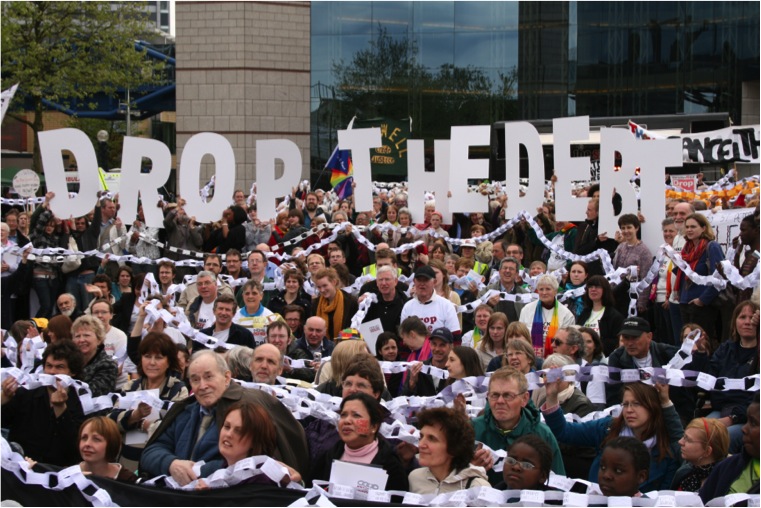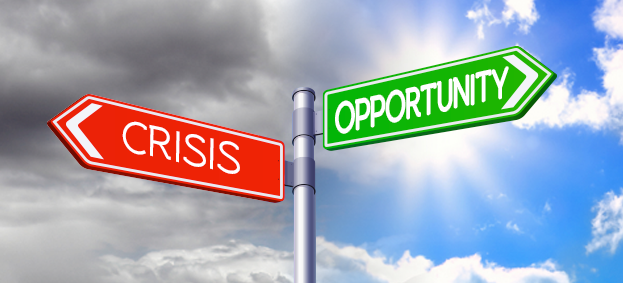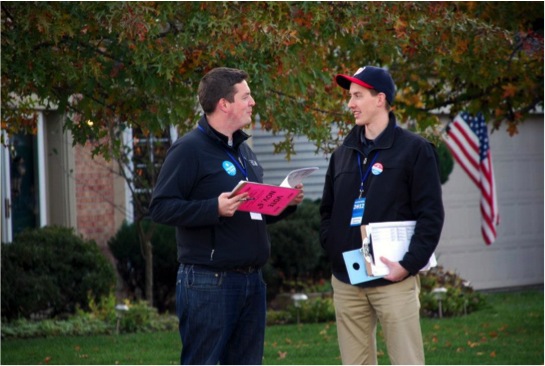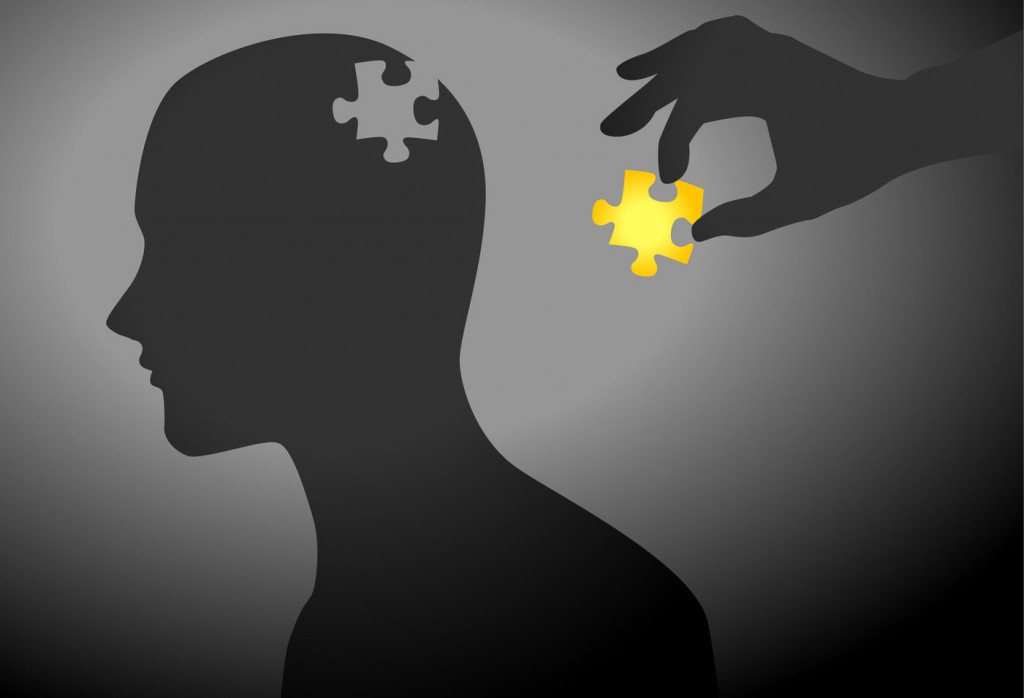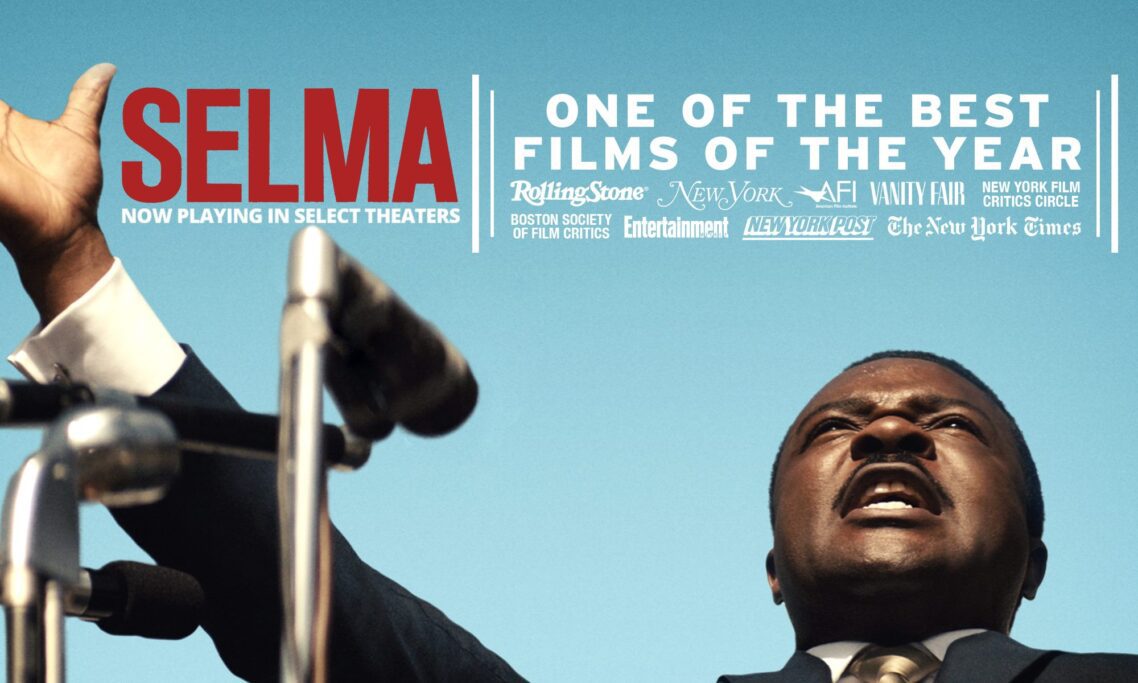In my role as Head of Campaigns and Engagement at Bond, I was ask to write about the trends that will impact the campaigning of members over the next 5 years, and what it means for our work to support members to campaign brilliantly. I came up with the following;
1 – Speed
The first campaign I was involved in was Jubilee 2000. I remember the record breaking petition, the sense of excitement as the latest Christian Aid News would come through the letterbox with an update, and the delighted when we heard we had succeeded in getting the G8 to cancel the unpayable debt.
It took the Jubilee 2000 campaign over 2 years to collect the 22 million signatures that formed the record breaking petition handed to G8 leaders. Anyone who collected those signatures will talk of the hours spent collecting petitions in churches, at street stalls and in student unions bars across the UK, winning the signatures one conversation at a time.
Fast forward to today, where it’s possible for a partnership between Guardian and Change.org to generate 250,000 signatures on FGM in 20 days, and many Bond members are able to generate tens of thousands of emails in a matter of days or weeks. Campaigning organisations able to launch a campaign in a matter of moments in respond to the latest event or news headline.
But while campaigning is getting faster, we’re also seeing a rise in slow activism? Organisations like the One Campaign and Tearfund are encouraging supporters to write handwritten letters to MPs around the recent legislation on 0.7% or All We Can encouraging supporters to stitch mini-protest banners ahead of London Fashion Week, part of creative ‘craftavist’ movement, which encourages reflective action that seeks to change the participant as much as it does the world. I think we need both within our movement, and a willingness to learn from both approaches.
2 – Sophistication
We know more about our supporters than we ever have, what actions the like to take, what topics they’re interested in, if and when they’ll open their emails from us, and as a result we can target our campaigns in more and more sophisticated ways. A recent report suggested “neuro-campaigning” following politics and advertising to use a better understanding of how our own brains work to persuade people to take action. With all this evidence, as campaigners we need to continue to invest more and more in testing of our messages and tactics before we share them.
A focus on what tactics to use, shouldn’t mean we overlook the importance of theories of change at the heart of our campaigning, including challenge ourselves to ask if we’re too focused on targeting our campaigning towards MPs, Government Ministers and UN bodies, or if we should follow Action Aid focusing on local councillors, or corporate divestment championed by Share Action and 350.org, or local media like RESULTS.
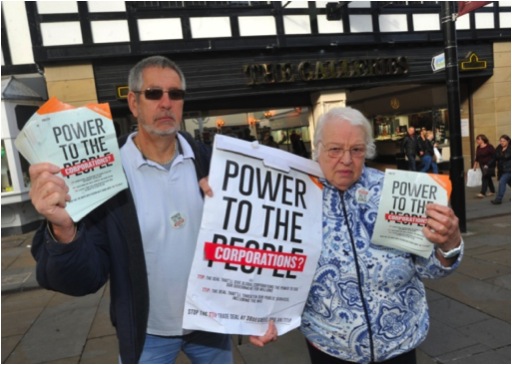
3 – Structures
As much as we need to build campaigning structures that are fit for a digital era, we shouldn’t overlook the importance of investing in an active and vibrant grassroots network. For me it’s always been the hallmark of our movement, the local activists that collect names on petitions and meet with their MPs.
I want to learn from groups like 38 Degrees, about how they mobilised 10,000+ volunteers as part of the Days of Action on TTIP, or Toys will be Toys, an entirely volunteer led campaign about how they’re successfully joining up offline and online actions.
A focus on structures should not only be about how campaigns are organised, but also about challenging the very structures that perpetuate inequality and poverty. While we should take advantage of opportunities like the recent Private Members Bill on 0.7%, but the danger in focusing on ‘the little big thing’ is that we risk not building public understanding about the root causes of poverty that should be central to our campaigning.
4 – Space
The Lobbying Act or comments by the former Charities Minister that we should ‘stick to knitting’ reinforce to me that we’re seeing a narrowing of the political space campaigning organisations have to advocate. I believe we should feel proud as a sector of the positive impact our campaigning has had on the lives of the communities we work with. We should all fight to protect it.
Before starting at Bond, I helped to found Campaign Bootcamp, a training programme for those looking to start a career in campaigning. We were overwhelmed by the generosity and enthusiasm we found to help us. That experience has shown me the strength of the community we have, committed to work together to share and help each other.
This is an edited version of an article first published in The Networker available here.
Category: learning
How campaigners can help ensure crisis equals opportunity..
It’s an appropriate question given the headlines on the current refugee crisis, and the opportunities for advocacy and influence that it appears to be providing for many groups who’ve toiled on these critical issues for years.
So how do we, as campaigners prepare for those crisis, that cause a set of fundamental assumptions or rules to be challenge in such dramatic way.
It’s all to easy to see crisis as something to be avoided, but as this excellent article on the missed opportunities for progressives from the 2008 financial crisis suggests ‘crisis equals opportunity, for those who are ready to use it’.
1. Take time to prepare – We can’t anticipate every crisis, but how much time do we spend preparing what we might do.? Look around at those who’s job it is to respond to unexpected crisis, from the security forces, who play our scenarios often on a grand scale, to the staff in the humanitarian response departments of many large NGOs. They role play. It means in the unlikely event of those situations happening they know how to react most effectively.
Can campaigners learn a thing from this? One of the things I enjoy most about Campaign Bootcamp that I helped to set up is the way we use a scenario to bring the campaigning that we’re teaching too life. I’m struck by how little we actual play out how we’d respond to different scenarios. How many team away days are dedicated to exploring what we’d do if.
2. Have a set of asks on the shelf – The father of free market economics, Milton Freedman is often quoted ‘When that crisis occurs, the actions that are taken depend on the ideas that are lying around. That, I believe, is our basic function: to develop alternatives to existing policies, to keep them alive and available until the politically impossible becomes the politically inevitable’ so campaigners for change’.
Do we have the same for the issues that we’re campaigning on? It doesn’t need to be long document, but something that could be dusted down. It might be seen as an indulgence, but I’m struck how the 2008 financial crisis came and many of those working on economic issue didn’t have a set of responses ready to go. There were opportunities to push for significant change but we didn’t have those asks to hand..
3. Look for the signs – Predicting crisis isn’t easy but taking time to learn the skills of those who effectively predict what might happen is a useful skill to add to a campaigners toolkit. What is that they were looking out for that helped, what was the evidence that they saw that led them to a different conclusion to the mainstream?
In the Pathways to Change: 10 Theories to Inform Advocacy and Policy Change Efforts, the authors talk about the ‘Large Leaps’ theory of change, suggesting that change can happen in sudden, large bursts that represent a significant departure from the past. The theory holds that conditions for large-scale change are ripe when the following occur:
As campaigners are we looking out for those signs?
4. Hold your nerve, but don’t cry wolf – There’s a risk that anyone who focuses on looking for a crisis can cry wolf. Spotting what they perceive to be a crisis, but isn’t actually one. Do this too often and your credibility can take a hit. The skill for any campaigner is to hold steady, seeking the evidence that the crisis is real and calling out the opportunities. One of the things that we’re going to be discussing with Tearfund colleagues is the difference between the opportunities presented by the climate and financial crisis. Perhaps the different here is the climate crises feels like its a long-term challenge, while the financial crisis was a much more sudden shock that we didn’t anticipate.
5. Present a positive vision – Crisis are unsettling, things we thought in the past were true are no longer, and at that moment its easy for campaigners to revert to the ‘told you so’ high ground, but as George Lakey suggests “when crisis comes, who is ready with what vision?”. In this article he argues that the both Occupy and 1968 French Student protest failed in part because they didn’t have positive vision that gripped the mainstream. He suggests that ‘in addition to campaigning, I would add another building block: Try empowering the visionaries you know to do homework. We’ll need their vision work — in concert with wide discussion — for the next crisis’.
Lessons from the Field – my reflections on 5 years organising for the Labour Party
Last month I shared a few thoughts about what issue campaigner can learn from party political campaigning.
A few people encouraged me to do the opposite post, but as I started writing I discovered this isn’t really lessons for political parties from campaigning organisations, it’s more my reflections from 5 years as a volunteer campaign organiser within the Labour Party.
Some caveats to start with. My experience is perhaps an isolated one, I’ve been focused on working in support of one party in a few constituencies in SW London, and I can’t say that I’ve managed to address everything I’ve written in the constituency I was involved in, but they’re a few observations, which feel timely as the Labour Party considers its future direction.
I’ve tried to avoid too much of a focus on the idea that too many party members are focused on the minutes of the last meeting, that we send too many emails (which we do!) or we only visit at election time (which we don’t).
Why? Yes, it’s sometimes true we do all those thing but it’s also an unfair parody. Many of those I’ve worked alongside have been committed, dedicated individuals who put in hours of volunteer time determined to make a difference in their community. Instead I’ve chosen to reflect on the following.
1. Don’t forget to evaluate – I’ve been through a number of election campaigns now, they’re all different, but in all of them I’ve spotted things I’d do the same or do differently. It’s surprised me that the political parties don’t have a instinctive or systematic approach to sitting down, evaluating the evidence and learning what’s worked and what hasn’t.
Perhaps its because politics is always moving along, win and you’re into governing. Lose and the last thing you want to do is reflect on what you did wrong, but it’s a practice that needs to be encouraged at all levels of the party. Personally, despite feeling numb from the result of the election in May, I’m glad the Labour Party has committed to do a full review of what worked and didn’t work, and it’s great to see some of the candidates do the same. That needs to become the norm not the exception, and the findings need to be distributed widely.
2. Test, trial and try new – Elections are in many ways won (or lost) using the same formula that parties have been using for years. Yes, there are a few examples of doing differently (Birmingham Edgbaston is the example that was rightly praised in 2010 and Ilford North in 2015) but outside a few campaigns committed to pioneering , and the work of the Labour digital team who I think awesome, new approaches seem to be to too often few are far between and not mainstreamed quickly.
Innovation is hard when the risk of it not working is losing an election, and not all campaigning organisations get this right either. But I’d love to see the party embrace a culture of testing different approaches to see what has the biggest impact, trailing something new, building an evidence base based on experimentation.
It doesn’t mean throwing the old playbook out (there is much to be said for the approach of going door to door and being routed in a community) but the playbook needs to have some (evidence-based) chapters added to it.The experience of Arnie Graf and the suspicion with which his community organising approach was viewed is a lesson in how hard this can be.
3. Share learning – In the overall scheme of things I was a fairly unimportant volunteer. But with a (unhealthy) passion for campaigning that took me to the US to learn how Obama did it in 2012, I was amazed at how little learning and good practice is proactively shared amongst other volunteer campaign organisers. I’m sure there is loads I could learn from others across the UK, but I found more ideas from reading books and blogs about what was happening in the US than I did others in the UK.
The Labour Party would do well to emulate a model similar to that of the Analyst Institute in the US and build a closed community committed to share evidence and best practice for paid staff and key volunteers (like me). But learning shouldn’t be limited from within the Party, since the election its been more interesting reading learning from Conservative activists, like any good campaign the party needs to be open to collecting ideas for a range of sources.
4. Remember the pyramid of engagement – A graph like the one below should go up in every Labour Party office. Sure some really skilled professional people just love to deliver leaflets (I’m one of them now – it’s good exercise) but too often that’s all we ask them to do, just knock on doors or deliver leaflets.
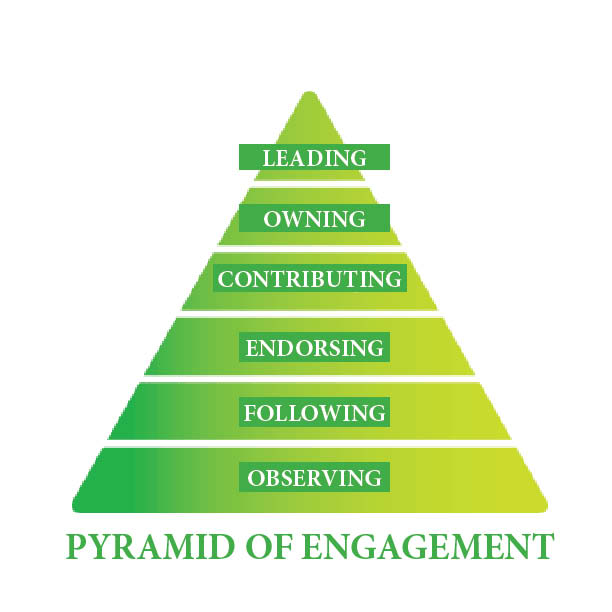
The pyramid of engagement is a tool well know to campaigners, all about how you help you develop a plan to recruit individuals and engage individuals. Some constituencies do this really well, but sadly most don’t meaning talent is wasted or under-utilised.
5. Invest in your people – The Labour Party relies on a small army of organisers in many of its constituencies, most are recent graduates paid too little, and asked to make huge sacrifices of time in the run up to an election. Some are stick around for year, but most drift away after an election or two. That’s valuable institutional knowledge walking, and a huge cost in training new staff.
We don’t have the culture in the UK of a professionalised political campaign staff, but as a result there a few incentives for the most effective organisers to stick around, the training they get seems to be patchy and the support/supervision from more experienced staff limited. Building a clear career pathway that rewards the most effective rather than those who have the most stamina, and effectively scales to provide the right level of support and supervision is needed if we’re to build a cadre of brilliant campaign managers.
6. Build a culture of accountability – At times, asking how another constituency how many contacts it’s made is similar to asking someone else how much they get paid. It’s shared with reluctance and is probably over or under inflated! Work needs to be done to ensure the metrics are more sophisticated than simply the number of contact made, although that’s still an important benchmark of activity, to ensure they’re capturing volunteer engagement and much more.
But those figures need to be shared and scrutinised. To my mind it’s unacceptable that we don’t have a culture where one constituency can benchmark itself against another and those who aren’t performing, including where we have longstanding MPs, are called out by the National Executive Committee or another representative body.
So a few lessons from me. As I was writing this I re-read parts of Refounding Labour. It’s a document full of practical recommendations. It would be easy for whomever becomes leader in September to bin it, as a holdover from the previous leadership, in my opinion that would be a mistake.
Get my latest posts sent directly to your inbox – sign up here.
Five for Friday – Winning the support needed
I’ve been thinking a lot over the last few weeks about the importance of starting with the audiences you need to win, rather than the activists we already have.
So this Five For Friday is a collection of articles that have helped my thinking in the last few weeks;
1 – Kirsty McNeill on the difference between ‘people power’ and ‘activist power’ and the importance of understanding that difference.
2 – How the Equal Marriage campaigners in the US realised they needed to change the framing of the message (and the 10 lessons from the campaign)
3 – I’ve shared this before, but Roger Harding on how Shelter moved housing up the agenda is a must read for all campaigners.
4 – 10 years on from Make Poverty History, here are some reflections from the lessons of a campaign that got 90% brand recognition from Kirsty (again!) and my colleague Alice Delemare.
5 – More insight from how the Conservatives did this so well in the last election by ruthlessly focus on the people who matter.
10 years later – some personal reflections on Make Poverty History
2005 was a good year, I got engaged, England finally beat the Aussies to win the Ashes, and I got to work on the Make Poverty History campaign.
Make Poverty History was the first big campaign that I’d be paid to work on. It was a huge movement that mobilised 100,000s of people to take action on debt, aid and trade as the UK government hosted both the G7 and the EU Presidency.
This week, its a decade since the biggest moment of the campaign, a huge 250,000 person march in the centre of Edinburgh, accompanied by the Live 8 concerts on the eve of G7 leaders meeting in Scotland.
10 years later, and it’s still the campaign that I mention when I try to explain what I do to my second aunt.
While lots has been written about the impact of the campaign, being the first campaign that I was really involved in organising I’ve been reflecting on the campaigning lessons that Make Poverty History taught me. There are lessons that still apply today;
1. Unusual coalitions deliver change – at the time, I remember a friend who worked in a totally unrelated job at Number 10 talking about how the unexpected partnerships around the table the campaign was creating waves internally. Bringing together 500+ organisations meant that the campaign couldn’t be dismissed as just ‘the usual suspects’.
2. Be prepared for the second act – I’ve written about this before, but the campaign ran for the whole of 2005, concluding in a Mass Lobby of Parliament in the rain on trade justice in November, but because the majority of the resources had been deployed to ensure the push towards the G7 moment was as successful as it needed to be, the campaign didn’t have the resources for the ‘second act’ causing a loss in momentum over the summer, and the impression by some that the campaign had come to an end.
3. Sometimes you need to let it go – I remember that it quickly became apparent that the campaign had captured the public imagination, individuals were calling up with , events being organised across the country, churches want to wrap their spire in WhiteBands (the symbol of the campaign) and much more.
Now we’ve become very used to the idea of more decentralised ‘bottom up’ campaigning, an approach pursued by groups like 38 Degrees, but at the time it was uncomfortable for organisations who’d been used to a more ‘command and control’ approach to managing their campaigns. If our campaigns are to come to life we have to be prepared to let the brand run a little wider than we’d immediately feel comfortable.
4. A good campaign has a halo effect on its targets – most of the MPs who were lobbied as part of the campaign probably can’t remember the details of the policy asks from the time, but the impact of the campaign have lasted well beyond 2005. Long after the campaign has come to an end politicians who were lobbied still mention Make Poverty History. As we get further away from 2005, that effect is definitely declining, but even today I think we’re getting wins on international development issues as a result of the campaign.
5. A campaign can benefit from a ‘radical flank’ – the tensions within the campaign, between organisations who had different political and policy analysis have been written about elsewhere, but the campaign was a excellent examples of the concept of the ‘radical flank’ when the positive or negative effects that radical activists for a cause have on more moderate activists for the same cause. Did those groups who took more ‘radical’ position help mean that the asks of the campaign were seen as more ‘moderate’ by the government and thus achieved?
6. The transaction costs of building coalitions are high – Make Poverty History was over a year in the making before it was launched in early 2005, it took many hours of meetings and discussions to reach agreement, a reminder that the start-up costs of forming coalitions are often significant. This work was helped by a tradition of working together that had come from previous campaigns on debt and trade by many of the key organisations, the need to keep this type of infrastructure in place is vital to build trust and bring individuals and organisations together.
7. Building public support is really hard – Make Poverty History had a brand recognition of 90%, but despite all the high profile media, celebrity involvement and grassroots chatter, the evidence suggests that it didn’t lead to a significant increase in the number of people ‘very concerned’ about global poverty issues. It’s a reminder that building public support requires sustained attention (and perhaps using the right frames).
8. Don’t be afraid to try something new – The campaign adopted this approach ‘“don’t be afraid to be the first to ‘crack’ a new platform, give trendy a try, and take a risk!”. In many ways Make Poverty History was the first internet campaign, albeit one with a campaign video where you had to select the speed of your dial up connection, comfortable trying out new approaches as we sought to understand the power of the web for campaigning.
Looking back, I’m incredibly proud of the small role I played in the Make Poverty History campaign, it wasn’t a perfect campaign (here is a secret – no campaign is) but one that taught me so much but more importantly delivered real results.
I’ll take the memories of Vicars walking to Downing Street, Nelson Mandela in Trafalgar Square, getting sunburnt in Edinburgh, staying up all night on Whitehall, and getting very wet outside Parliament wherever I go in my campaigning career. It was a very special year.
Who are the best messengers for our campaigns?
A study out recently suggested that people could be persuaded to change their attitudes to same-sex marriage as the result of a 22 minute conversation with a gay canvasser.
It’s the type of research any issue campaigner is fascinated by. How to win someone over to support your argument.
Sadly those particular research findings have been discredited, but it got me thinking what does the evidence say about who the most effective individuals we can use to persuade audiences to support our campaign.
Here are a few studies I’ve come across;
- People are persuaded by people like them. Studies of field organising in election campaign has shown that if you want canvassers similar to the target population your trying to reach, I suspect that their is something in this for all those looking to persuade.
- The public have high levels of trust in academics and experts. They consistently perform well as the most trusted spokesperson in the Edelman Trust Barometer (incidentally in the study, NGO spokespeople also perform well, but those figures are dropping).
- Celebrities have a mixed impact. They don’t have the affect that you’d expect amongst the general public, although when asked the public think that they’ll be effective at persuading others, but they can be effective at gaining access to decision makers who believe they represent public sentiment.
- Change.org have proven the power of the personal stories of their petition starters, while the personal testimony to engage action is at the heart of the community organising approach of Citizens UK. The Story of Self, Us and Now is a effective tool to use, because research shows the human brain has a natural affinity for remembering facts and statistics when presented in a narrative construction (a story to you and me!).
- Whoever says it, make sure they say it again, and again and again. Its an age old adage from the marketing industry, but a good reminder to campaigners who get bored of the same message quickly. Those working on housing issues found it took a year of repeating and repeating the same core message to see the polling move.
This is my short list of studies, but please do use the comments box below to add others you know about.
Five for Friday – Post-Election Special
The election might be old(ish) news, but the last week has generated some useful reading for campaigners.
1 – A wise campaigner learns from those who win. The Guardian has a exclusive video of Lynton Crosby sharing his insights, while the Spectator profiles the approach of American Jim Messina.
2 – Chris Rose has been here before, he shares his reflections on what campaigners should prepare to do next.
3 – Jim Coe asks if the election raises some more strategic questions for campaigners.
4 – Chloe Staples at NCVO has two brilliant posts on working with the new Parliament and new MPs, plus tips from the former MP for High Peak.
5 – Housing has raced up the political agenda over the last 5 years. Roger Harding shares some lessons from Shelter.
Feel free to post great post-election reads in the comment section below, and if you missed it, my thoughts are here.
Now What? 9 post-election thoughts
I’ll leave others to dissect why Labour lost, what the left in England can learn from the SNP, if now is the time to campaign for electoral reform and more.
While personally I’m gutted at the result having spent 5 years of my spare time organising for a Labour win, for now a few thoughts for campaigners from the last 30 days;
It’s time to re-read the Conservative manifesto. Put aside the work you did on what similarities it had with the Lib Dem manifesto, and what you’d like to see in a coalition agreement, perhaps also have a re-read of the 2010 Conservative manifesto as well, it could contain policy clues to what they might have done if they’d not been in coalition after the last election.
We need to ensure our campaign messages resonate in places like Lincoln, Nuneaton and Thurrock, not simply within Zone 1 – 2 – This article on why Labour struggled is bang on, but can the same can be said for many NGO campaigns? It’s easy for our campaigns to receive adulation on twitter, but do they play well to the floating voters on the High Streets in the marginal seats across the country?
The small majority might be an opportunity, so campaigns that have cross-party support, can work with independently minded Tories who can leverage their influence or find ways to demonstrate to those Tory MPs with small majorities that votes on a specific issues will cost them at the next election could win. It could mean uncomfortable coalitions, but it could mean successful campaign.
We (probably) won’t have another election until 2020, but elections in Scotland, Wales and London are less than 12 months away, as is a referendum on Europe, start planning for them now, but also keep an eye on the impact of the boundary reviews on the 2020 election.
Look at the campaign tactics that worked for the political parties. I’ve written before about elections being the birthplace of many campaign tactics that NGOs are using in years to come. The General Election had its fair share of clever tactics and approaches, some very smart digital tactics that the Labour Party used for example. This interview with the mastermind of the Conservative campaign, Lynton Crosby is worth a watch as well, as well as this list of NGO campaigns that cut through.
Parliament returns on 18th May but for lots of new MPs they’ll be spending the first few weeks actually looking for an office in Parliament, hiring staff, working out how to get emails on their phones, etc. Those campaigns and organisations that are helpful to new MPs are likely to be remembered favourably in the months and years to come.
Don’t forget those that didn’t get reelected, as Chloe Staples points out ‘It’s not inconceivable that many of these will turn up in the Lords or in public life in another way (perhaps in think tanks or even as charity chief executives!) so don’t forget to maintain the relationships you have so carefully built over the last five years’. So if you champion is returning later in the month, don’t forget to thank them.
The environment for campaigning could get tougher. It’s unlikely that repeal of the Lobbying Act is going to be easy (but that doesn’t mean we shouldn’t try), but we need to be prepared for bigger battles to come on the space for charities to campaign, like protecting CC9 the guidance that allows us to influence, which the government is likely now to review.
We need more charity campaigners to get involved in party politics. Some have suggested that charity workers shouldn’t be active members of political parties. It’s not a position that I agree with, not only does it seem illogical, many of those we’re fighting against are lobbyists who are member of political parties, but being involved in election campaigning has helped me to be a better campaigner, its taught me about what issues people really think about, how to mobilise volunteers, and much more.
4 things you should know about monitoring and evaluation in campaigning
I keep getting asked questions about monitoring and evaluation in campaigning. I’ve no idea why but here are a few of my reflections on the challenges (and opportunities).
1- It’s as much an art as it is a science – This paper is one of my favourite on the topic suggests that “Advocacy requires an approach and a way of thinking about success, failure, progress, and best practices that is very different from the way we approach traditional philanthropic projects such as delivering services or modeling social innovations. It is more subtle and uncertain, less linear, and because it is fundamentally about politics, depends on the outcomes of fights in which good ideas and sound evidence don’t always prevail”. Simply put trying to apply evaluation approaches from programme work are unlikely to work, as INTRAC suggests “The reality is that evaluating advocacy is hard. There is no magic bullet and systems”.
2 – What your measuring is often just the tip of the iceberg – Jim Coe has just authored this paper which suggests “the most significant benefits (of campaigning) are often submerged: difficult to measure, to monetise and sometimes even to see. It’s right to anchor advocacy to rigorous assessment. But calculations of value can risk focusing only on the part that is visible, generating misleading information and encouraging poor decision-making”, suggesting, amongst other things, that we should approach advocacy as inherently speculative, as “not all advocacy efforts will pay off, so plan for, and take a long term view of, “aggregate return” on advocacy rather than focusing on individual successes”.
3 – Focus on the transformational as well as the transactional – when you set objectives its easy to focus on the outcomes (transactional) like the number of actions taken, open rate on an email or attendance at event. As this paper suggests your metrics “should capture quantity and quality, numbers and nuance, transactions and transformations” recognising the importance of the impact of your advocacy on transformations “the vital but sometimes “invisible” work. They show how people, organisations, and movements have been altered through the collective efforts”.
4 – Don’t ignore it – In the busyness of a campaign focusing on monitoring and evaluation can feel like a luxury, but here are some useful tools for quick evaluation. Simply put, any serious campaign should focus on investing in both monitoring and evaluating, while recognising that most of the impact you won’t see until long after your grant/campaign has ended, so its always good to think about going back to review campaigns you’ve run a while back.
I’d also encourage all campaigners to get better at sharing their evaluations. It’s time we had an ‘open evaluation’ movement to unlock and share all the learning across our campaigns to help each other. Feel free to use the comment sections to post links to any in the comment section below.
Looking for more ideas? This report from UNICEF has lots of useful tools and approaches.
Lessons in how change happens from #SelmaMovie
If you take nothing else from this post. Go see the movie Selma.
I promise you its the most powerful film you’ll see this year, and a ‘must watch’ for anyone interested in how change happens.
Much has been written about Martin Luther King and the Civil Rights Movement, but walking out from seeing Selma I was struck by a few lessons that should resonate for all campaigners;
1 – You can’t go alone – The film centres on the leadership of Martin Luther King, played brilliant by David Oyelowo, but throughout the film you see the importance of the role of the other leaders of the Southern Christian Leadership Coalition (SCLC). When wrestling over strategy, training the movement or negotiating with those in power, your reminded that although Luther King led the movement, he was ably supported by individuals like Abernathy, Lewis and Young. He need these companions to support him both strategically and spiritually as leader.
2 – You need to build your movement – In preparation for seeing the film I’ve been enjoying Taylor Branch’s ‘Pillar of Fire’, its a brilliant history of the Civil Rights Movement, and while the film touches on the work of the Student Nonviolent Coordinating Committee (SNCC), the book is reminder of the work that happened in places like Selma, Greenville, and elsewhere across the south, it was SNCC and others who worked to register voters and build consciousness amongst black communities. For movements to have moments like the marches in Selma you need to be committed to the hard work of organising before them.
3 – Have your second (and third) act planned – The film shows what strategic mastermind that King was, as he prepares for the Selma to Montgomery marches, he knew that his presence would draw nationwide media coverage. While the film doesn’t shed light on if the outcome of the Bloody Sunday march, where marches were viciously attacked by the local Police and State Troopers, could have been predicted, it’s clear that King was aware that he would need to call a second march (known as Turnaround Thursday) to increase the pressure on President Johnson and show the resolve of the movement. To often campaigns plan for the big moment but don’t think what they’ll do next.
4 – Capitalise on your opponents mistakes – As King explains why he’s moved the campaign to Selma, their is an interesting dialogue about why the campaign had ‘failed’ in Albany, Georgia, because local Police Chief, Laurie Pritchett, had studied the non-violent principles and developed a strategy to response which had muted the effectiveness of the movement, and the expected response of Selma Sheriff, Jim Clark, who they anticipated would respond in the violent way he did, helping to gain attention for the campaign. Throughout the film you see how Luther King sought to understand his opponents and exploit their weaknesses. Like a Judoka, he skilfully ‘throws’ his opponents using their power/strength.
5 – Use all the tactics available to you – While the film centres on the marches in Selma as part of the push to get the Voting Rights Act, through the film you also see how Dr King and the SCLC used a range of tactics available to them to put pressure on President Johnson to push the Act through Congress, from legal challenges, media, use of celebrities, to building diverse coalitions, although the SCLC focused on mass mobilisation, it sought to use all the approaches available to it.
